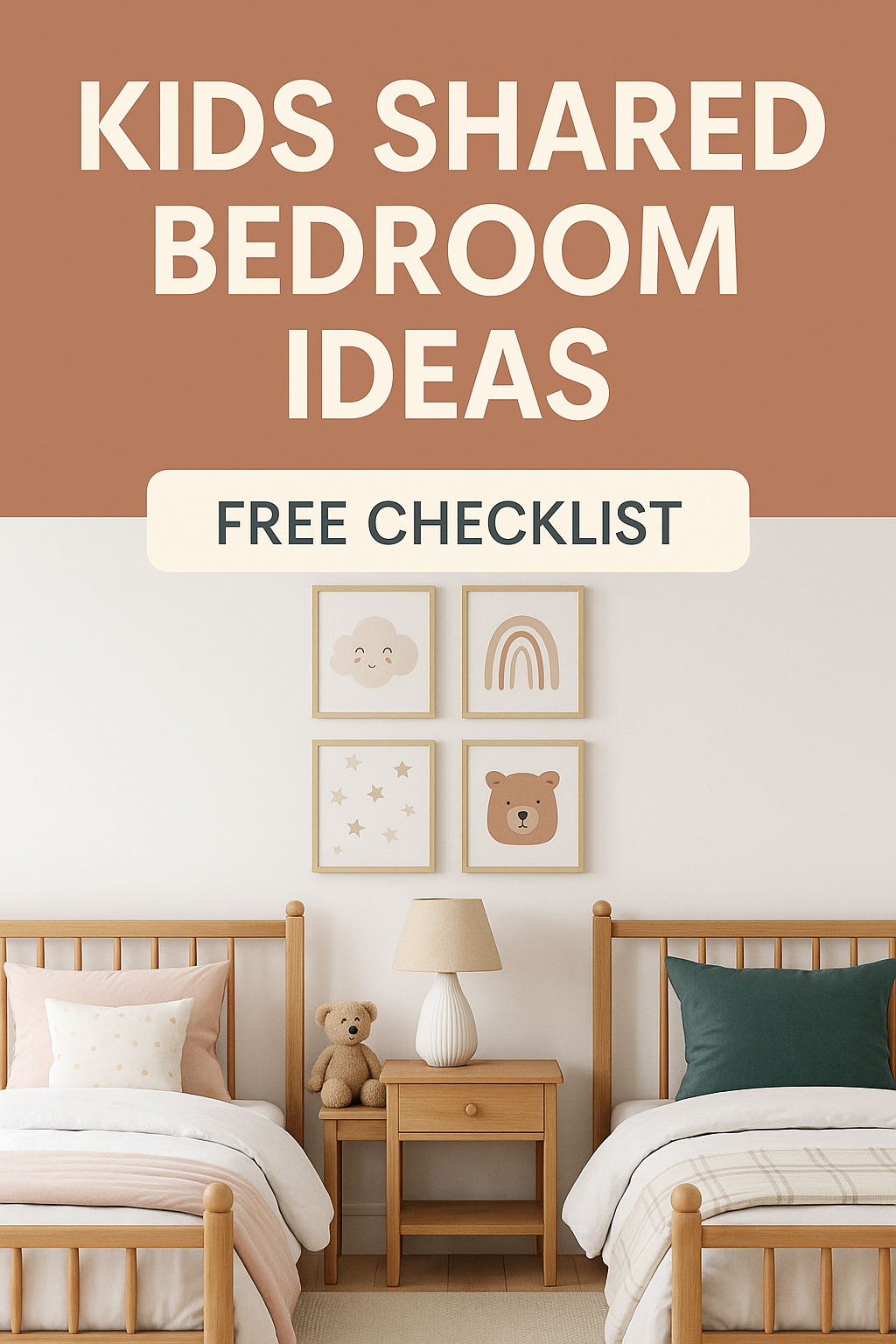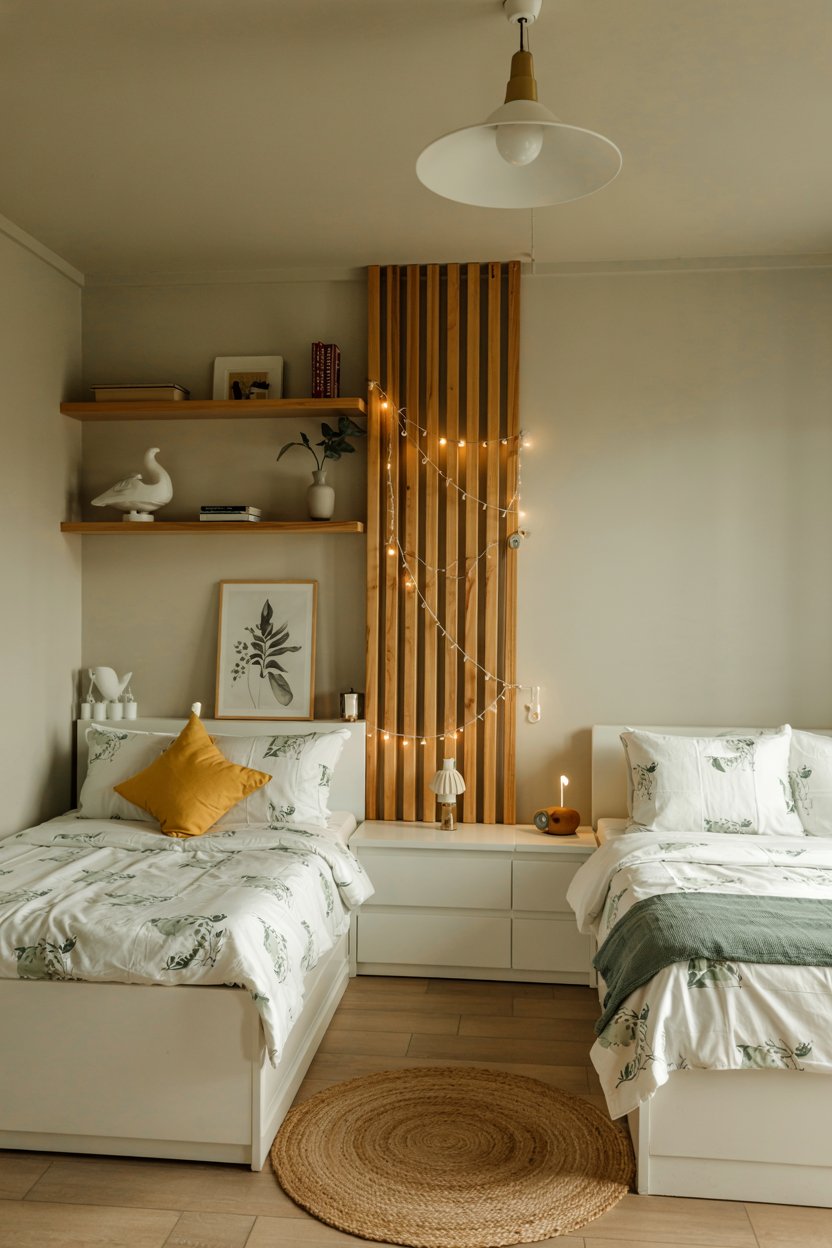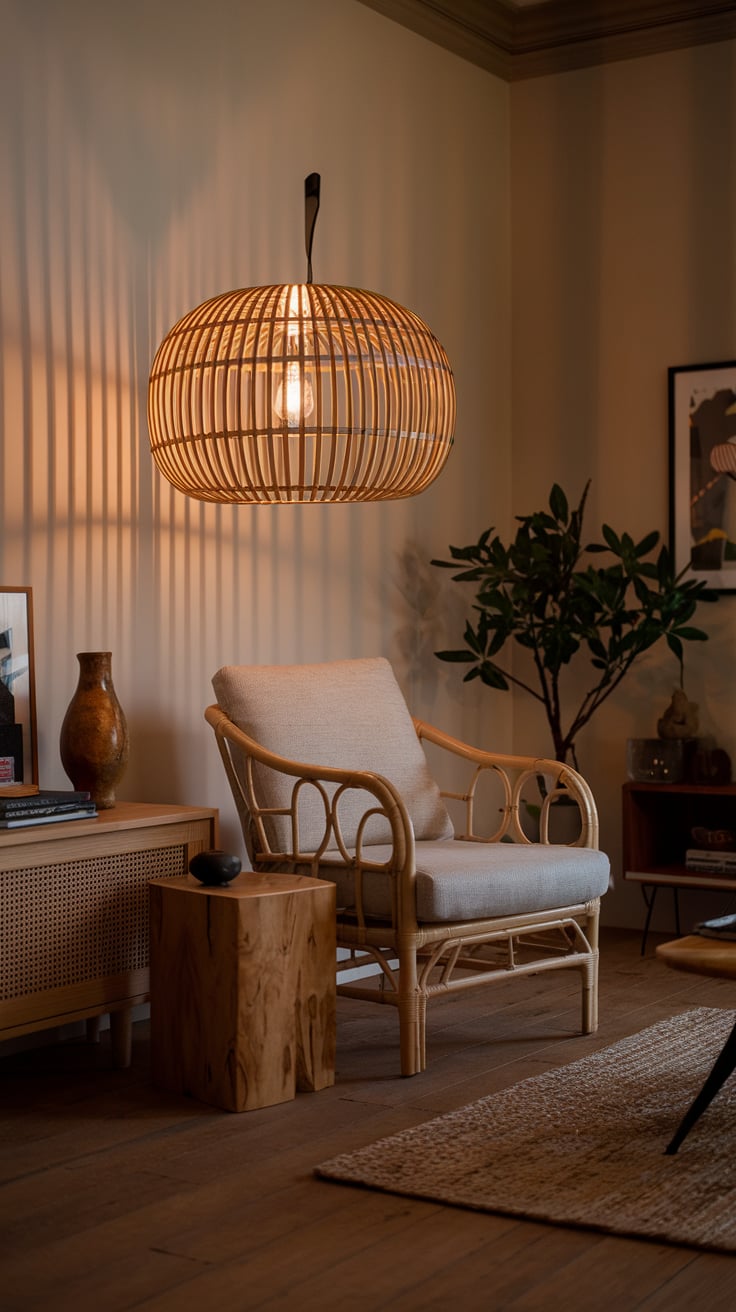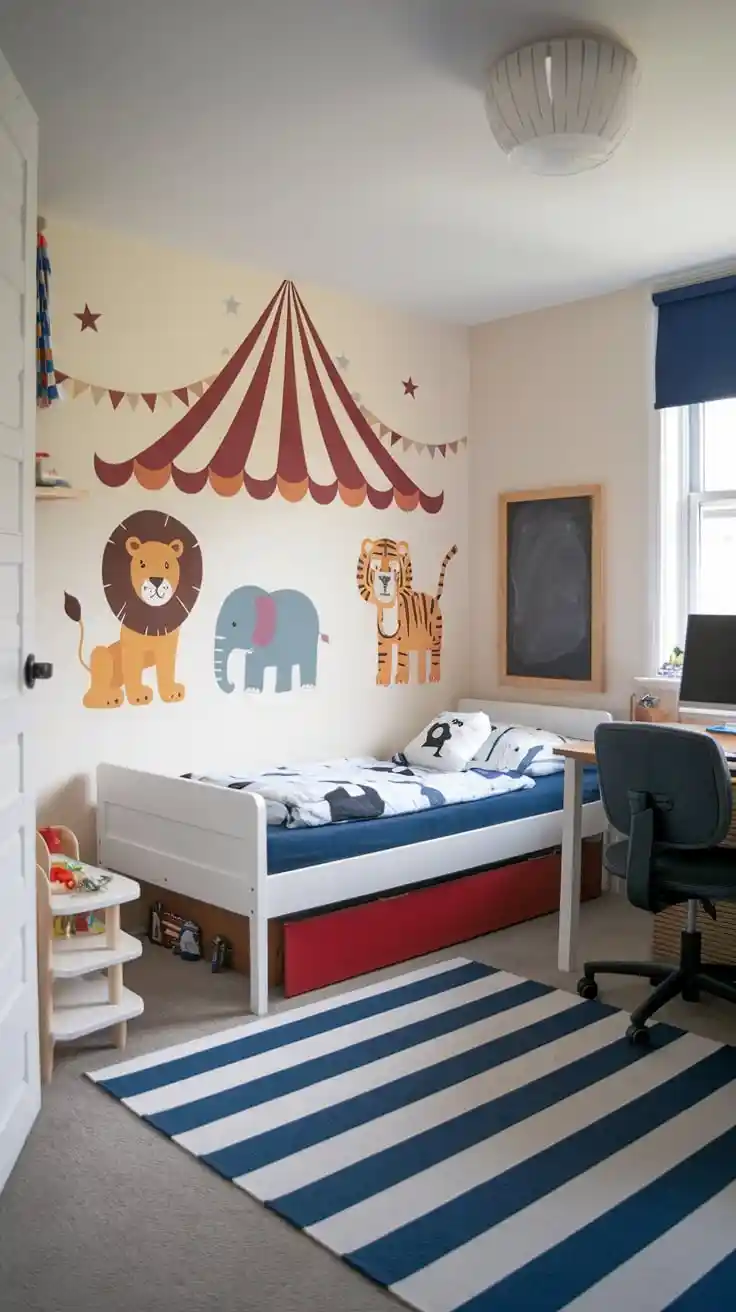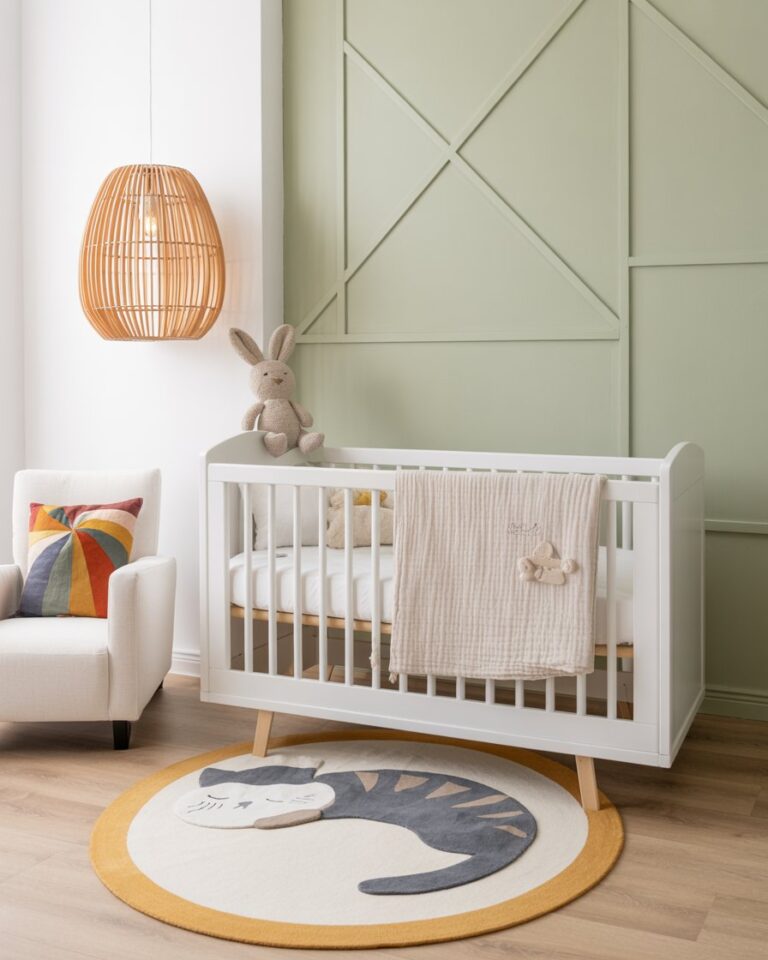🛏️ Kids Shared Bedroom Ideas: Smart, Stylish, and Stress-Free Solutions
Sharing a room can be a challenge—but with the right setup, a kids shared bedroom can become a cozy, functional space both siblings love. Whether you’re working with limited square footage or just want to foster sibling bonding, this guide is packed with practical tips, creative layout ideas, and space-saving solutions to make shared rooms work beautifully.
From bunk bed setups to storage hacks and personal zones, you’ll find everything you need to create a peaceful, stylish space—without sacrificing anyone’s personality or sanity.
Let’s dive into the best kids shared bedroom ideas that truly work.
Designing a kids shared bedroom starts with understanding the people who’ll be living in it. A good setup goes beyond furniture — it’s about meeting each child’s needs while making the space functional, organized, and visually cohesive.
This post may contain affiliate links, please see privacy policy for details.
Start With a Game Plan
Before moving a single bed or buying a new dresser, consider these key factors:
- Age differences: A toddler and a tween have very different needs (and bedtimes). Their areas should reflect that.
- Gender considerations: Opposite-gender siblings may want visual or physical boundaries for privacy, especially as they get older.
- Personalities and interests: Does one child need quiet reading space while the other loves building LEGO sets for hours? Plan accordingly.
- Storage needs: Are you drowning in clothes, books, or toys? Storage solutions must be built-in from the beginning.
- Room dimensions: Measure everything. You’d be surprised how often beds and dressers don’t fit like you imagined.
Pro Tip: Sit down with your kids and involve them in the planning process—it’ll help them feel invested and reduce pushback later.
Smart Layouts That Actually Work
Room layout is the foundation of a successful shared space. Choose a layout that supports both form and function:
🛏️ Side-by-Side Beds
- Works best in longer rooms
- Easy to decorate symmetrically
- Add individual nightstands for separation
📐 L-Shaped Beds
- Perfect for square rooms
- Opens up central play space
- Allows for more personalization
🪜 Bunk Beds
- Ultimate space-saver
- Great for sleepovers or small rooms
- Look for models with stairs or built-in drawers for added safety and storage
- Top-rated bunk beds on Amazon
🏕️ Loft Beds + Zones
- Ideal for school-aged kids
- Loft bed on top, desk/play zone underneath
- Saves massive floor space
- Kids loft beds with desks
📚 Divider Furniture Layout
- Use a tall bookshelf, cube organizer, or curtain to create visual separation
- Offers some privacy without building a wall
- Great option for tweens or opposite-gender siblings
Reminder: It’s not just about fitting beds into a room — it’s about creating a layout that lets your kids sleep, play, grow, and store their stuff without tripping over each other.
🎨 Design Ideas for Every Personality
In a shared bedroom, the challenge is blending individual expression with cohesive design. You want the room to feel unified, but also give each child a sense of ownership and identity. These design ideas help you strike that balance—without compromising on style or sanity.
Matching But Not Identical
You don’t have to go full matchy-matchy. Instead, aim for “coordinated but unique” with these tips:
- Choose a unifying theme or color palette, like neutrals with pops of blue and pink
- Use matching furniture (beds, dressers), but personalize each side with unique bedding or wall art
- Hang name signs above each bed (check cute personalized signs on Amazon)
- Add monogrammed pillows or framed art made by each child
Bonus: Let your kids choose one or two decor items for their space—they’ll feel like the room is theirs, too.
Color Schemes That Work for Two
Picking the right color combo can make or break a shared room. Here are a few that always work:
🎨 Gender-Neutral Palettes
- Sage green, ivory, and wood accents
- Navy and mustard
- Greyscale with pastel pops
🎨 Shared Color, Different Accents
- Base: White or light grey
- Kid #1: Coral, mint, or blush
- Kid #2: Teal, yellow, or indigo
🎨 Color-Blocked Walls
- Divide the room with paint—one color for each child’s side
- Use painter’s tape for clean, geometric separation
👉 Need inspiration? Browse our post on Blue Boho Bedroom Ideas or explore Girly Pink Bedroom Designs to spark ideas.
Wallpaper, Murals & Feature Walls
Set the tone of the room with a feature wall behind the beds:
- Peel-and-stick wallpaper in fun patterns or subtle neutrals
- Chalkboard paint for creativity and change
- Decals like rainbows, constellations, or jungle themes (great options on Amazon)
- A gallery wall with each child’s favorite art
Design Tip: Don’t overwhelm the space—limit bold patterns to one wall or one corner to keep things balanced.
Cozy Decor Touches Kids Love
- String lights or fairy lights
- Canopy or bed tent for a cozy retreat
- Themed throw pillows (dinosaurs, stars, rainbows, etc.)
- Wall-mounted clipboards or corkboards to display their changing artwork
Keep decor soft, swappable, and practical. You’re not just decorating—you’re creating a space where your kids feel safe, relaxed, and represented.
🧸 Shared Bedroom Storage Hacks
Let’s be honest—two kids means double the stuff. The secret to a stress-free kids shared bedroom isn’t just clever layouts—it’s storage that works hard. These space-saving solutions keep the room organized, reduce clutter, and help kids take ownership of their space.
Under-Bed Storage That Makes Sense
That space under the bed? Gold mine. Use it to hide off-season clothes, toys, or extra bedding:
- Rolling bins with labels for toys, clothes, or craft supplies
- Under-bed drawers (some bunk and platform beds come with them built-in)
- Zippered fabric storage bags for clothes and linens
Pro Tip: Use clear containers so kids can see what’s inside (and you won’t get 20 “Mom, where’s my…” questions a day).
Go Vertical: Use That Wall Space
Think up, not out. Walls are underused real estate in most kids’ rooms.
- Floating wall shelves for books or treasures
- Pegboards for baskets, hats, art supplies
- Wall-mounted bins or hanging organizers (multi-pocket versions on Amazon)
- Over-the-door hooks or shoe organizers for accessories and small toys
Bonus: Vertical storage keeps the floor open for play.
Double-Duty Furniture
Choose furniture that does more than one job:
- Storage ottomans at the foot of each bed
- Bedside tables with drawers or baskets
- Bookshelves used as room dividers to give each child their own zone
- Cube organizers with labeled bins (great for toys, socks, or seasonal gear)
These pieces help control clutter without crowding the space.
Shared Closet Systems That Work
If your kids share a closet, you’ll need a plan to keep it functional and fair.
- Color-coded bins or baskets (one color per child)
- Install a second hanging rod for lower clothes access
- Add shelf dividers and drawer units to contain chaos
- Use vertical hanging organizers for shoes, hats, or stuffed animals
- Top-rated kids closet organizers that make setup easier
Label everything. If it’s not labeled, it’s going to turn into a junk pile. That’s the rule.
Toy Storage Without the Mess
No more stepping on LEGO barefoot in the middle of the night. These toy storage solutions are kid-friendly and parent-approved:
- Stackable toy bins (clear and labeled)
- Toy hammocks for stuffies
- Rolling carts for craft supplies or collections
- Book slings or display shelves to encourage reading
Rotate toys seasonally and donate regularly—less stuff equals less stress.
🧠 Personal Space in a Shared Room
Even the most bonded siblings need a little breathing room. A shared bedroom should feel like a shared space, not a competition for privacy. Whether your kids are the same age or years apart, these ideas help carve out clear personal zones within one unified room.
Visual Boundaries Without Walls
Use design elements to subtly divide the room so each child feels like they have their own domain:
- Area rugs under each bed to define zones
- Color-blocked walls — one side blush, one side teal
- Wall decals or murals that distinguish each child’s space
- Room divider curtains or tall bookshelves (see options)
💡 Tip: Let kids help choose the color or pattern for “their” side—it builds connection and ownership.
Decor That Reflects Individual Personality
Let each child express themselves, even in small ways:
- Wall hooks for hats, headphones, or favorite bags
- Shadow boxes or corkboards to showcase drawings or treasures
- Custom name signs or framed initials (personalized wall art)
- Floating shelves above each bed for their “special stuff”
This encourages independence and keeps items from getting mixed up.
Creating Separate Work or Play Areas
If space allows, carve out a quiet zone for each child:
Homework or Reading Nooks
- Use small desks or a long shared desk with dividers
- Add clip-on lamps and pencil holders for each side
- Compact desks for small rooms
Mini Play Corners
- Play kitchens, LEGO tables, or dollhouses can be placed strategically
- Use floor cushions or beanbags for soft reading/play spots
If room is tight, consider rotating who gets floor play space each week. It gives both kids something to look forward to.
Built-In Privacy for Older Kids
As kids grow, so does their need for privacy—especially in tween and teen years. A few upgrades can make a big difference:
- Bunk bed curtains or canopies
- Headboard shelving with cubbies or USB outlets
- Noise machines or headphones to block distractions
- Use a bed tent or canopy for a cozy, private retreat
Sharing a room doesn’t mean giving up personal space—it just means getting more creative with how it’s defined.
🛏️ Bed Options That Save Space (and Fights)
The right beds can make or break a kids shared bedroom. You’re juggling sleep schedules, space limitations, and sibling squabbles—so choosing the right setup is crucial. These space-saving bed options not only look great but also keep the peace and maximize functionality.
Bunk Beds: The Classic Space-Saver
Bunk beds are the gold standard for shared rooms—and for good reason:
- Vertical design frees up floor space
- Great for small or narrow rooms
- Some models include built-in drawers or bookshelves
- Look for stairs instead of ladders for younger kids
🛒 Shop top-rated bunk beds on Amazon
Pro Tip: Choose a bunk with detachable beds in case you ever want to separate them later.
Trundle Beds: Sleepovers, Solved
Trundle beds are perfect when you need a second bed without sacrificing space 24/7.
- Roll-out trundle fits under a standard twin
- Tucks away neatly when not in use
- Ideal for siblings with occasional overnight guests
- Many options include storage drawers too
🛒 Browse best-selling trundle beds here
Loft Beds With Built-Ins
If one child is older or needs more personal space, loft beds are a game changer.
- Sleep on top, desk or play zone underneath
- Adds function without expanding the footprint
- Perfect for tweens or school-aged kids
- Can be paired with a lower bed on the other side
🛒 Shop kids loft beds with desks
Toddler and Convertible Beds
When your kids are at very different developmental stages (think baby + preschooler), it helps to mix and match.
- Convertible cribs for infants
- Toddler beds with side rails for safety
- Keep the layout adaptable as they grow
- Place toddler beds closer to the door for easier access at night
🛒 Check out toddler bed options
Beds With Built-In Storage
Multifunctional furniture = fewer fights over closet space.
- Captain’s beds with under-bed drawers
- Platform beds with pull-out baskets
- Headboards with cubbies for books and treasures
- Great for minimalist setups and shared rooms without closets
🛒 Top space-saving kids beds here
Choosing the right bed setup is more than just saving space—it’s about creating a room your kids actually enjoy being in.
🧼 Keeping the Peace: Rules and Routines
Even the most Pinterest-perfect kids shared bedroom can descend into chaos without structure. The secret to long-term success? Set clear boundaries, routines, and expectations—before the first bedtime squabble. These tips help you build a shared space that’s not just functional, but peaceful too.
Set Boundaries to Avoid Conflict
Sharing a room teaches valuable life skills—but it also requires rules. These boundaries help reduce bickering and build respect:
- Personal zones are sacred. No touching each other’s beds, shelves, or bins without permission.
- Quiet time is non-negotiable. Use a sound machine or dim light to signal downtime.
- Toys stay in shared spaces—or follow a “take turns” rule.
💡 Tip: Write out a roommate-style agreement together and hang it on the wall. Kids love structure they helped create.
Share Responsibility
It’s not all on one kid to clean up or organize the room. Make it fair:
- Chore charts for tidying, dusting, or making beds
- Rotate weekly “room leader” duties—who picks the playlist, who turns off the light, etc.
- Color-code bins, hangers, or towel hooks to keep responsibilities crystal clear
🛒 Reusable magnetic chore charts can keep things consistent without nagging.
Create Sibling-Friendly Bedtime Routines
When two kids share a room, bedtime needs structure—or everyone loses sleep.
- Staggered bedtimes for siblings of different ages
- Shared storytime followed by individual quiet time
- Use sound machines or fans for background noise
- Add clip-on reading lights to avoid waking each other
🛒 Top-rated kids sound machines and clip-on lights
Encourage Emotional Check-Ins
Don’t wait for a full-blown meltdown—make space for feelings:
- Ask: “How’s it going sharing the room?” weekly
- Encourage kids to talk to each other directly (with coaching if needed)
- Validate their feelings—even if the problem is “he’s breathing too loud.”
Sometimes, simply being heard fixes 90% of the issue.
Consistency is the secret sauce. When kids know the rules and routines, they feel safe—and that leads to fewer arguments, better sleep, and way less mess.
🛍️ Decor and Accessory Ideas
Once the layout is set and routines are in place, it’s time to bring the space to life with kid-approved decor. The right accessories don’t just make a room feel cozy—they boost functionality, spark creativity, and help define personal space. Here’s how to decorate a kids shared bedroom without the overwhelm (or overspending).
Lighting That Works for Two
Lighting in a shared room needs to be flexible. These options give each child control over their space while keeping things soft and sleep-friendly.
- Clip-on reading lights — attach to bed frames for nighttime reading
- String lights or fairy lights — add whimsy and warmth without being too bright
- Night lights with dimmers — ideal for different sleep needs
- LED strip lights under beds or desks for a modern touch
🛒 Top-rated kids reading lights and night lights
Wall Decor That Inspires
Give your kids walls that do more than hold up posters:
- Personalized name plaques or initial wall letters
- Growth charts to track milestones
- Inspiring quotes or affirmations in bold, kid-friendly fonts
- Clipboards, bulletin boards, or art rails to display drawings and schoolwork
🛒 Cute wall decor kits for kids
💡 Want a dreamy feminine twist? See our Girly Pink Bedroom Designs. Prefer something modern and minimal? Explore Neutral Nursery Ideas.
Rugs, Curtains, and Bedding
These soft goods anchor the design and help define personal zones without major changes:
- Two different but coordinating bedding sets (like stars and stripes, or dinosaurs and rainbows)
- Room-darkening curtains to help kids sleep better
- Area rugs to create mini zones for each child
- Canopies or bed tents for privacy and play
🛒 Best-selling bedding and curtain bundles
Pro Tip: Choose machine-washable everything. Shared bedrooms = double the mess.
Decorative Storage = Clutter Control
Even decor can do double duty:
- Storage ottomans with cute fabric covers
- Woven baskets or canvas bins in fun patterns
- Wall-mounted hooks for hanging headphones, hats, or backpacks
- Toy hammocks for stuffies
🛒 Stylish and functional storage bins
The goal: Make it easy for your kids to put things away—and feel good about the space they’re in.
🛒 Amazon Favorites for Shared Kids Rooms
Need quick wins? These top-rated Amazon finds are perfect for making a kids shared bedroom more functional, organized, and fun—without breaking your brain or your budget.
Every link below is parent-approved and designed to save space, reduce clutter, or make bedtime smoother. (Affiliate links included – thank you for supporting the blog!)
🛏️ Best Space-Saving Beds
- Bunk bed with storage drawers and stairs – smart, sturdy, and safe for little ones
- Loft bed with built-in desk – ideal for older kids needing study space
- Twin bed with trundle – great for sleepovers or staggered bedtimes
🧸 Toy & Storage Solutions
- Stackable cube organizer with bins – use as a divider or toy station
- Under-bed rolling storage containers – keep extra clothes and toys tucked out of sight
- Toy hammock for stuffies – finally off the floor!
🛋️ Smart Furniture That Does More
- Storage ottoman for kids rooms – doubles as seating
- Kids reading nook bean bag chair – soft, cozy, and perfect for downtime
- Bookshelf with room divider height – great for visual separation
💡 Decor, Lighting & Privacy
- Clip-on reading lights – lets each child read without disturbing the other
- Bed canopy for kids – adds a cozy, private feel
- String lights or LED strip sets – soft light + total vibe
🎨 Personal Touches
- Wall decal sets – easy to remove and reposition
- Personalized name signs – make their side feel special
- Magnetic chore charts – smooth out responsibilities without constant reminders
You don’t need to renovate to make a shared room amazing—you just need the right tools and decor to make it feel like home for both kids.
👉 Don’t forget to save this post or Pin it for later!
❓ FAQ: Kids Shared Bedroom Questions Answered
How do you design a kids shared bedroom that works for different ages?
Start by identifying each child’s individual needs—such as sleep routines, toy storage, or study space. Use flexible layouts like bunk beds or divided zones, and choose age-appropriate decor that respects both developmental stages.
How can I give each child personal space in a shared bedroom?
Use visual cues like rugs, color blocking, or bed canopies to define each child’s zone. Add individual shelves, name signs, or storage bins so they feel a sense of ownership over their side of the room.
What’s the best bed setup for a shared bedroom?
Bunk beds and loft beds are great for saving space, especially in small rooms. Trundle beds work well for sleepovers, while twin beds with storage drawers underneath are ideal for older kids who want their own space.
How do I keep a shared bedroom organized?
Prioritize multi-functional furniture like beds with drawers or cube organizers. Use labeled bins, vertical shelving, and under-bed storage to maximize every inch. A shared chore chart helps keep both kids accountable.
Can siblings of opposite genders share a room?
Yes—especially in early childhood. As they grow, provide more privacy using curtains, dividers, or separate bedding and decor styles. Keep communication open and be ready to reassess as their needs change.
What if one child is messy and the other is tidy?
Establish ground rules about cleanliness and shared responsibilities. Use labeled bins and closed storage to contain clutter. Consider dividing the room visually so each child can manage their own space.
What’s the ideal room size for two kids?
While there’s no perfect number, a minimum of 10×10 feet is generally workable. Layout efficiency, storage hacks, and vertical space use matter more than square footage alone.
How can I make a shared bedroom feel cozy and stylish?
Stick with a cohesive color palette, incorporate personalized decor for each child, and use soft textiles like area rugs, throw pillows, and blackout curtains. Focus on creating comfort zones for sleep, play, and creativity.
📌 Final Thoughts
Designing a kids shared bedroom isn’t about perfection—it’s about creating a space that works for your real-life family. With the right layout, smart storage, and just a few personalized touches, your kids can share a room that feels spacious, peaceful, and totally theirs.
Remember:
✔️ Plan around your kids’ actual needs
✔️ Define personal zones clearly
✔️ Use space-saving furniture and smart storage
✔️ Set up rules and routines early
Want even more inspiration?
📥 Grab your free printable Shared Bedroom Planning Checklist – includes layout sketch templates, storage planning prompts, and a shopping list to get you started.
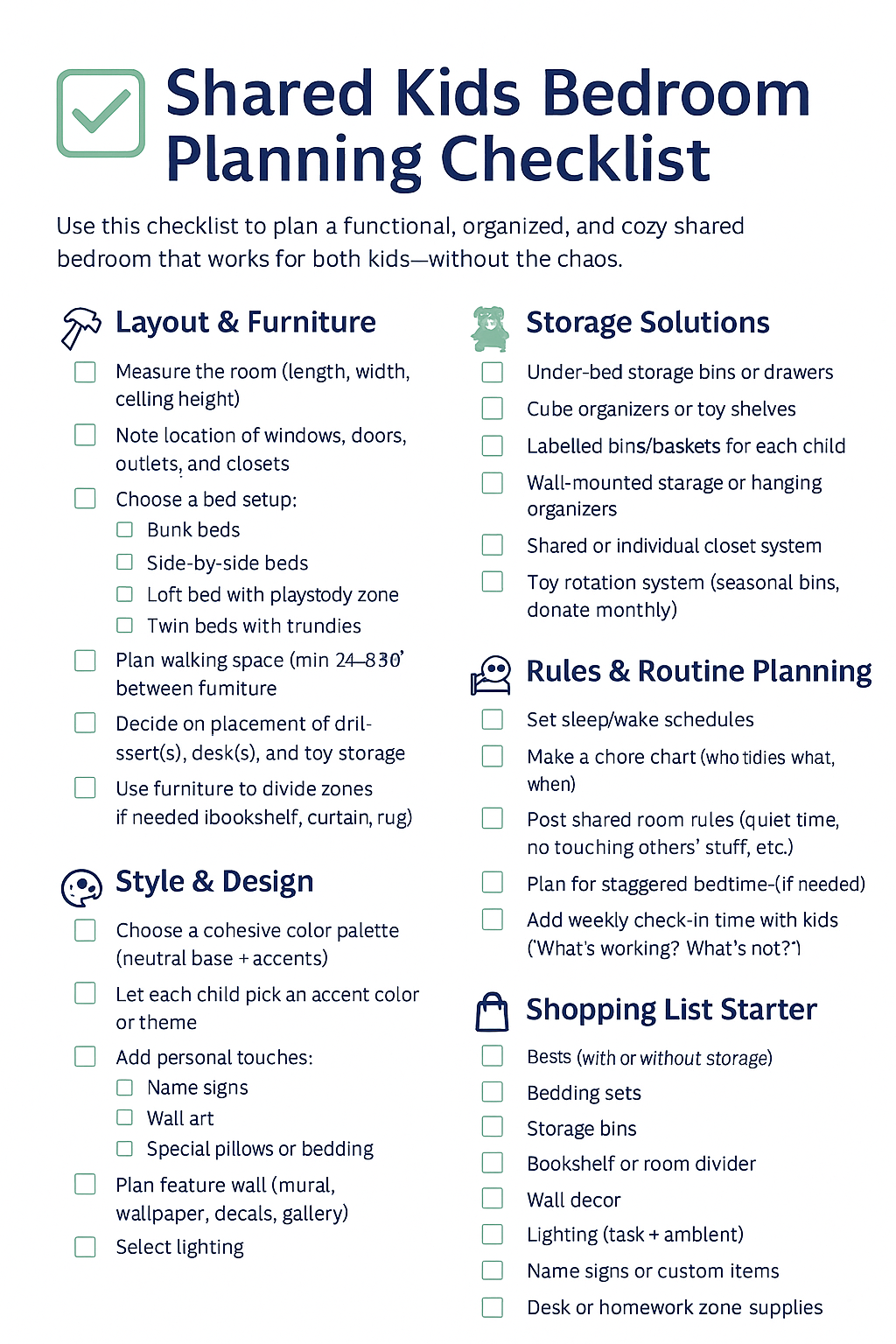
📌 Save this post to Pinterest so you can come back to it when you’re ready to redesign!
💬 Already created a shared room? Share your favorite tip or challenge in the comments below—I’d love to hear from you!
